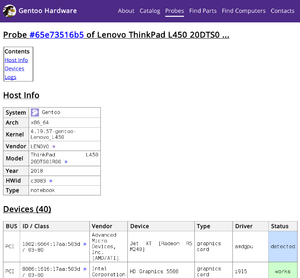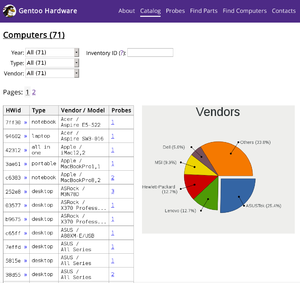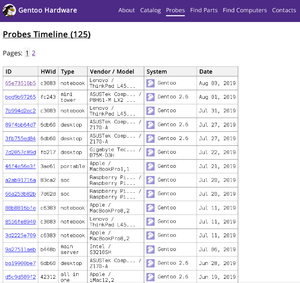hw-probe
The linux hardware database is an automatically created dataset, based on information collected through the hw-probe utility. The information accessible on the linux-hardware website can help to check operability of hardware devices, view logs and find drivers.
In addition to the sys-apps/hw-probe package provided in the Gentoo repository, there is hw-probe.AppImage and a flatpak.
The database is backed up to the linuxhw github repository for statistical analysis by third parties. The project is active, and there are currently new additions for Gentoo every day.
Install
Emerge
Install sys-apps/hw-probe:
root #emerge --ask sys-apps/hw-probeUsage
Invocation
user $hw-probe --help NAME:
Hardware Probe (hw-probe)
A tool to probe for hardware, check operability and find drivers
DESCRIPTION:
Hardware Probe (hw-probe) is a tool to probe for hardware,
check its operability and upload result to the BSD hardware database.
By creating probes you contribute to the "HDD/SSD Desktop-Class Reliability
Test" study: https://github.com/linuxhw/SMART
USAGE:
hw-probe [options]
EXAMPLE:
hw-probe -all -upload
PRIVACY:
Private information (including the username, machine's hostname, IP addresses,
MAC addresses, UUIDs and serial numbers) is NOT uploaded to the database.
The tool uploads 32-byte prefix of salted SHA512 hash of MAC addresses and serial
numbers to properly identify unique computers and hard drives. UUIDs are decorated
in the same way, but formatted like regular UUIDs in order to save readability of
logs. All the data is uploaded securely via HTTPS.
INFORMATION OPTIONS:
-h|-help
Print this help.
-v|-version
Print version info.
-dumpversion
Print the tool version (1.6) and don't do anything else.
GENERAL OPTIONS:
-all
Enable all probes.
-probe
Probe for hardware. Collect only
hardware related logs.
-logs
Collect system logs.
-log-level N
Set the logging level to N.
Available values:
- minimal
- default
- maximal
-minimal|-min
Collect minimal number of logs. Equal to --log-level=min.
-maximal|-max
Collect maximal number of logs. Equal to --log-level=max.
-enable LIST
Comma separated list of logs to enable in addition to
current log level.
-disable LIST
Comma separated list of logs to disable in current
log level. Some logs cannot be disabled. For example,
you can disable collecting of 'fstab', but you cannot
disable logging of 'smartctl'.
-printers
Probe for printers.
-scanners
Probe for scanners.
-check
Check devices operability.
-id|-name DESC
Any description of the probe.
-upload
Upload result to the hardware database. You will get
a permanent URL to view the probe.
By use of this option you confirm uploading of 32-byte
prefix of salted SHA512 hash of MAC addresses and serial
numbers to prevent duplication of computers in the DB.
-hwinfo-path PATH
Path to a local hwinfo binary.
-proxy ADDRESS:PORT
Set outgoing http/https proxy using syntax: proxy.domain.local:3128
INVENTORY OPTIONS:
-i|-inventory-id ID
Mark the probe by inventory ID.
-generate-inventory-id
Generate new inventory ID.
-email ADDR
Email for node status notifications.
MONITORING OPTIONS:
-start
Start monitoring of the node.
-stop
Stop monitoring of the node.
-remind-inventory
Remind node inventory ID.
OTHER OPTIONS:
-save DIR
Save probe package to DIR. This is useful if you are offline
and need to upload a probe later (with the help of -src option).
-src|-source PATH
A probe to upload.
-fix PATH
Update list of devices and host info
in the probe using probe data.
-show-devices
Show devices list.
-show
Show host info and devices list.
-show-host
Show host info only.
-verbose
Use with -show option to show type and status of the device.
-pci-ids PATH
-usb-ids PATH
-sdio-ids PATH
-pnp-ids PATH
Path to {pci,usb,sdio,pnp}.ids file to read missed device names.
-list
List executed probes (for debugging).
-clean
Do nothing. Obsolete option.
-save-uploaded
Save uploaded probes.
-debug|-d
Do nothing. Obsolete option.
-dump-acpi
Probe for ACPI table.
-decode-acpi
Decode ACPI table.
-import DIR
Import probes from the database to DIR for offline use.
If you are using Snap or Flatpak package, then DIR will be created
in the sandbox data directory.
Provide inventory ID by -i option in order to import your inventory.
DATA LOCATION:
Probes info is saved in the /root/HW_PROBE directory.Submitting information
Anybody can submit computer details to the database with a single command:
root #hw-probe -all -uploadProbe for hardware ... Ok Reading logs ... Ok Uploaded to DB, Thank you! Probe URL: https://linux-hardware.org/?probe=65e73516b5
Statistics
Creating a hardware probe contributes to following 2 projects and studies:
Privacy
Please note that a 32-byte prefix of salted SHA512 hashes of MAC addresses and serial numbers are uploaded to the server in order to properly identify unique computers and parts. These are unlikely to be reversible.
Private info is not collected. Moreover, it's safer to share logs by hw-probe rather than share manually, because most private data is removed or hashed at the client side before uploading.



